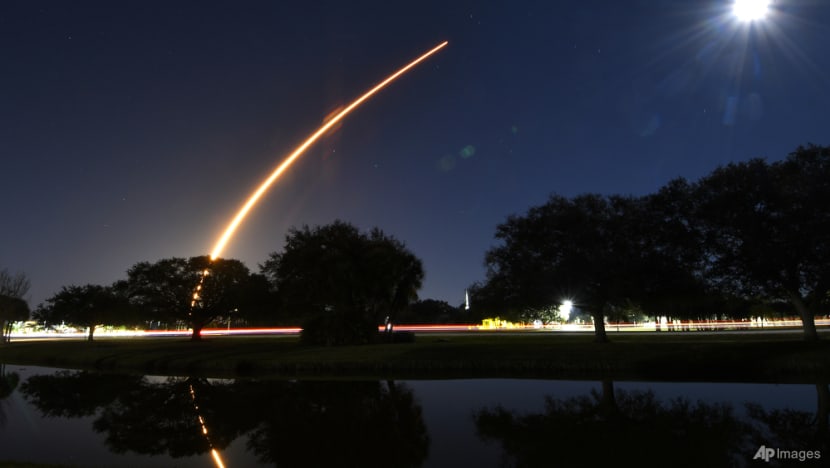Why billionaires are flinging satellites into ‘LEO’

In this image taken with a slow shutter speed, a SpaceX Falcon 9 rocket from Launch Pad 39A at Kennedy Space Center, arcs across the night sky in this view at Viera, Fla, Jan 18, 2022. The rocket, carrying 49 Starlink internet satellites, had a rare southern trajectory moving across a moonlit sky. (Tim Shortt/Florida Today via AP)
Close to 3 billion people have never used the internet, and billionaires Elon Musk and Jeff Bezos are on a mission that could narrow the digital divide. The two entrepreneurs are competing to launch thousands of small satellites that will zip around the globe in what’s known as low-Earth orbit (LEO).
They can be used to connect places that are too remote for ground-based broadband or have been cut off by natural disasters or conflict. The technology was put through its paces in Ukraine, where Musk’s Starlink system helped to keep civilians and the military online after Russian forces invaded. But colonising this special slice of Earth’s atmosphere comes with heavy startup costs as well as complex and potentially dangerous challenges.
HOW LOW IS LEO?
Most LEO satellites circle from 500km to 2,000km above Earth’s surface, so they can send data to the ground more rapidly than traditional communication satellites that are stationed at roughly 36,000km out. Those high-orbit systems have a median signal delay, or latency, of nearly 600 milliseconds for a round trip - too slow for technologies such as live video streaming, self-driving cars and high-frequency securities trading.
Starlink aims for latency as low as 20 milliseconds, which Musk hopes eventually to cut in half. At those speeds, LEO satellites may compete with the fastest ground networks.
WHY SO MANY SATELLITES?
Satellites that are closer to Earth see a smaller part of its surface, so you need more of them. Also, the speed needed for an object to keep a stable orbit - achieved by balancing its velocity with Earth’s gravity - increases in LEO, so a satellite must travel at about 27,000 kmh to stay aloft, circling the planet in 90 to 120 minutes.
As each satellite is only briefly in contact with a ground transmitter, another needs to appear on the horizon before the first goes out of view. To ensure there’s always a satellite overhead, you need lots of them strung out along crisscrossing paths that envelop the globe.
HOW WILL THE COMPANIES MAKE MONEY?
By selling their services to governments, businesses working in remote regions and providers of terrestrial 5G wireless and fixed-line broadband services that need to fill gaps in their own networks. They also aim to sell direct to consumers in poorer nations where broadband is patchy. For that, they’ll have to cut the cost of the ground terminals: A Starlink package costs US$599 in the US, excluding the connection fee. Past LEO projects such as Iridium, Globalstar and Orbcomm went bankrupt.
Related:
Today’s are more viable as satellite launch costs have plunged with the introduction of lighter, reusable rockets. Musk’s Falcon 9 can send up a satellite at a cost of US$2,600 per kilogram, down from roughly US$10,000 two decades ago. His company Space Exploration Technologies estimated that Starlink may cost up to US$30 billion to install, and Musk has said that annual revenue could eventually reach US$50 billion, helping to bankroll his ultimate ambition - colonising Mars.
WHAT ABOUT THE COMPETITION?
Musk’s rivals aren’t far behind. In April, Bezos’s Amazon.com struck the biggest launch deal ever, to send up more than 3,000 satellites for his Project Kuiper constellation. OneWeb, an LEO constellation controlled by Indian billionaire Sunil Mittal and the British government, plans to offer global coverage from 2023.
LEO networks from Canadian-backed Telesat, China, the European Union and others are in various stages of development. By the end of the decade, there could be more than 100,000 satellites zipping around the Earth, more than 20 times the number in operation in early 2022. Astronomers have already noticed the growing traffic, complaining that Starlink satellites are interfering with their view of space.
WHAT'S THE DOWNSIDE OF LEO?
Because the satellites are moving so fast, collisions are harder to predict and can be devastating. A 10cm chunk of debris traveling in LEO can contain about as much energy as 7kg of TNT, enough to shatter a satellite into thousands of pieces. Radar detection systems can estimate a satellite’s trajectory only to within a few miles as solar radiation and atmospheric drag make orbital paths slightly irregular.
LEO is already used by satellites for climate observation, Earth imaging and military purposes, as well as the International Space Station. It’s also littered with dead satellites and stray bits of old spacecraft. There’s a worry that a few collisions could cascade into further smashes, creating clouds of debris that put LEO’s most useful orbits off-limits for centuries. There are various proposals for removing space junk. But they would cost billions of dollars, and governments can’t decide who would pay the bill.













